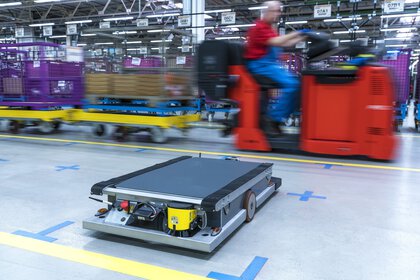Mobile transport systems are on the rise
Demand for mobile transport systems is booming. The number of logistics robots sold rose by a remarkable 60 percent in 2018, the International Federation of Robotics (IFR) reported. Almost 111,000 autonomous guided vehicles (AGV) were sold in 2018; the number was 69,000 in 2017.
“The market for driverless transport systems or automated guided vehicles (AGV) is currently exploding. The demand for our driverless transport systems is higher than ever,” Franz Wittich, Managing Director of Stäubli WFT, stated enthusiastically. Jan Drömer, CIO at E&K Automotion and spokesperson for Driverless Transport Systems department at VDMA, confirmed this: “The interest in mobile systems is huge.”
The enormous demand comes from a wide variety of market areas, starting from logistics applications of all kinds. “The manufacturing processes themselves are usually already fine-tuned down to tenths or hundredths of a second. On the other hand, logistics, supply and assembly still have a great deal of potential for savings,” Mr. Wittich reported.
Günter Krenz, Head of Assembly Technology at Bosch Rexroth, confirmed this: “Although users have often already automated assembly efficiently, material supply is still semi-automatic or even manual.” The consequence: “Intralogistics often occupies more space in the hall today than the actual production line.”
BMW uses Smart Transport Robots
BMW is also committed to mobile transport robots and has been using self-developed Smart Transport Robots (STR) in production logistics for two years. The STR, which BMW developed together with Fraunhofer IML, moves components through halls independently. BMW is also working on autonomous outdoor transport robots (called car trailers), which bring a truck trailer independently from the parking space to the unloading and loading station in a factory.
Another reason for the AGV boom is not only the optimization of production logistics but also the call for more flexibility, especially if the production processes are characterized by a high variety of variants. VDMA expert Mr. Drömer: “Especially in the automotive industry, the combination of decreasing lot sizes and a simultaneously increasing variety of variants is a major challenge. This no longer works with rigid processes and production lines.” Consequently, the trend in the automotive industry is to replace rigid production lines with highly flexible production systems.

Boom not limited to the automotive industry
The fact that the topic is not limited to the car sizes is shown by the example of the sensor manufacturer Sick, which has built a flagship factory at its Freiburg Hochdorf site that can also produce small batches up to batch size 1 economically. This is ensured by a production concept in which modular production stations, which are located in a hall like islands, are linked to one another via flexible driverless transport systems.
This desire for flexibility fuels the trend towards navigation solutions that are as flexible as possible. An increasing number of autonomous transport robots are coming onto the market, which navigate flexibly and are not tied to predefined and marked routes like conventional driverless transport systems. Bruno Adam, General Manager at Omron Mobile Robots Europe, likes to compare intelligent transport robots with taxis: “You can bypass obstacles and drive to different target spots independently at any time.” On the other hand, track-guided AGV are like trains: “They can only travel on predefined paths.”
Combination of cobot and mobile robot
Another trend in addition to autonomous navigation is the combination of a mobile platform and a handling robot placed on it. Alois Buchstab, Vice President Advanced Robotic Applications at Kuka, even celebrates this combination of a mobile robot and a collaborative handling robot as the “4th revolution in robotics.” Thanks to the combination of intelligent platform and handling robot, delivery and holding services, loading and unloading of machines, assembly activities at various locations, measurement tasks at test stations and much more can be automated economically.
Kuka has already converted the concept into a finished product with the KMR iiwa, which combines the lightweight robot LBR iiwa and a mobile, autonomous platform. Stäubli also provides this combination with the HelMo (“Assembly Helper”) as a marketable product. In addition to being used as assembly stand-ins, such systems are also suitable for flexible machine chaining. For example, the system integrator Baumann Automation uses a Stäubli HelMo for a customer from the machining sector. The HelMo robot automatically retrieves tools and holders from the tool store, moves them to the tool setup station and then to measuring and cleaning and finally inserts the tool into the machine. In the future, the HelMo will also be responsible for workpiece handling, quality control and packaging.
